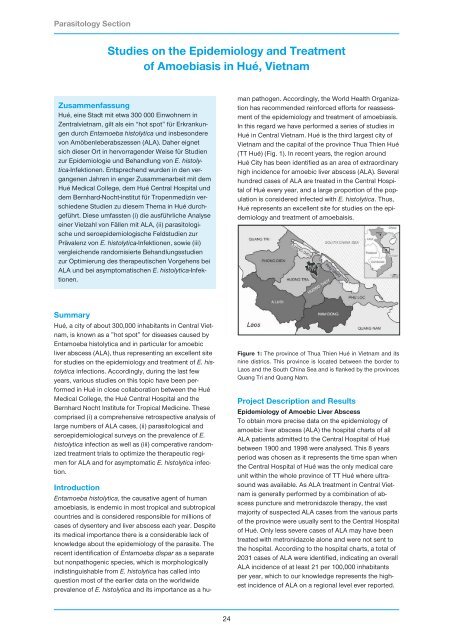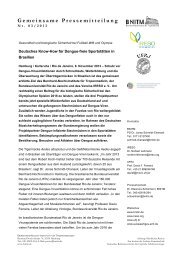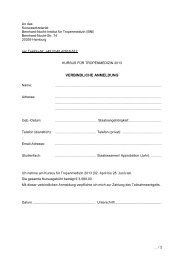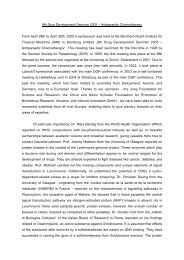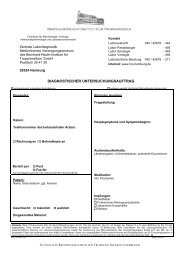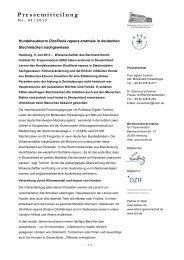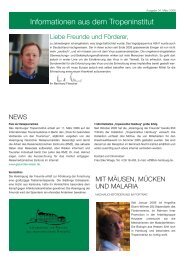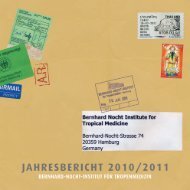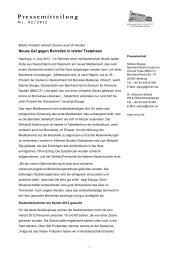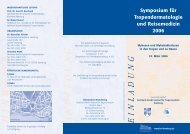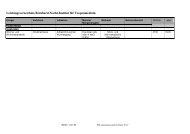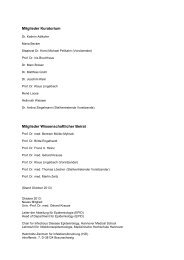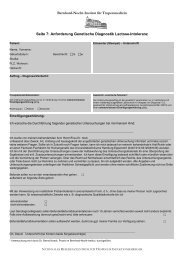Research Group Heussler (Malaria I) - Bernhard-Nocht-Institut für ...
Research Group Heussler (Malaria I) - Bernhard-Nocht-Institut für ...
Research Group Heussler (Malaria I) - Bernhard-Nocht-Institut für ...
You also want an ePaper? Increase the reach of your titles
YUMPU automatically turns print PDFs into web optimized ePapers that Google loves.
Parasitology Section<br />
Studies on the Epidemiology and Treatment<br />
of Amoebiasis in Hué, Vietnam<br />
Zusammenfassung<br />
Hué, eine Stadt mit etwa 300 000 Einwohnern in<br />
Zentralvietnam, gilt als ein “hot spot” <strong>für</strong> Erkrankungen<br />
durch Entamoeba histolytica und insbesondere<br />
von Amöbenleberabszessen (ALA). Daher eignet<br />
sich dieser Ort in hervorragender Weise <strong>für</strong> Studien<br />
zur Epidemiologie und Behandlung von E. histolytica-Infektionen.<br />
Entsprechend wurden in den vergangenen<br />
Jahren in enger Zusammenarbeit mit dem<br />
Hué Medical College, dem Hué Central Hospital und<br />
dem <strong>Bernhard</strong>-<strong>Nocht</strong>-institut <strong>für</strong> Tropenmedizin verschiedene<br />
Studien zu diesem Thema in Hué durchgeführt.<br />
Diese umfassten (i) die ausführliche Analyse<br />
einer Vielzahl von Fällen mit ALA, (ii) parasitologische<br />
und seroepidemiologische Feldstudien zur<br />
Prävalenz von E. histolytica-Infektionen, sowie (iii)<br />
vergleichende randomisierte Behandlungsstudien<br />
zur Optimierung des therapeutischen Vorgehens bei<br />
ALA und bei asymptomatischen E. histolytica-Infektionen.<br />
Summary<br />
Hué, a city of about 300,000 inhabitants in Central Vietnam,<br />
is known as a ”hot spot” for diseases caused by<br />
Entamoeba histolytica and in particular for amoebic<br />
liver abscess (ALA), thus representing an excellent site<br />
for studies on the epidemiology and treatment of E. histolytica<br />
infections. Accordingly, during the last few<br />
years, various studies on this topic have been performed<br />
in Hué in close collaboration between the Hué<br />
Medical College, the Hué Central Hospital and the<br />
<strong>Bernhard</strong> <strong>Nocht</strong> <strong>Institut</strong>e for Tropical Medicine. These<br />
comprised (i) a comprehensive retrospective analysis of<br />
large numbers of ALA cases, (ii) parasitological and<br />
seroepidemiological surveys on the prevalence of E.<br />
histolytica infection as well as (iii) comperative randomized<br />
treatment trials to optimize the therapeutic regimen<br />
for ALA and for asymptomatic E. histolytica infection.<br />
Introduction<br />
Entamoeba histolytica, the causative agent of human<br />
amoebiasis, is endemic in most tropical and subtropical<br />
countries and is considered responsible for millions of<br />
cases of dysentery and liver abscess each year. Despite<br />
its medical importance there is a considerable lack of<br />
knowledge about the epidemiology of the parasite. The<br />
recent identification of Entamoeba dispar as a separate<br />
but nonpathogenic species, which is morphologically<br />
indistinguishable from E. histolytica has called into<br />
question most of the earlier data on the worldwide<br />
prevalence of E. histolytica and its importance as a hu-<br />
24<br />
man pathogen. Accordingly, the World Health Organization<br />
has recommended reinforced efforts for reassessment<br />
of the epidemiology and treatment of amoebiasis.<br />
In this regard we have performed a series of studies in<br />
Hué in Central Vietnam. Hué is the third largest city of<br />
Vietnam and the capital of the province Thua Thien Hué<br />
(TT Hué) (Fig. 1). In recent years, the region around<br />
Hué City has been identified as an area of extraordinary<br />
high incidence for amoebic liver abscess (ALA). Several<br />
hundred cases of ALA are treated in the Central Hospital<br />
of Hué every year, and a large proportion of the population<br />
is considered infected with E. histolytica. Thus,<br />
Hué represents an excellent site for studies on the epidemiology<br />
and treatment of amoebaisis.<br />
Figure 1: The province of Thua Thien Hué in Vietnam and its<br />
nine districs. This province is located between the border to<br />
Laos and the South China Sea and is flanked by the provinces<br />
Quang Tri and Quang Nam.<br />
Project Description and Results<br />
Epidemiology of Amoebic Liver Abscess<br />
To obtain more precise data on the epidemiology of<br />
amoebic liver abscess (ALA) the hospital charts of all<br />
ALA patients admitted to the Central Hospital of Hué<br />
between 1900 and 1998 were analysed. This 8 years<br />
period was chosen as it represents the time span when<br />
the Central Hospital of Hué was the only medical care<br />
unit within the whole province of TT Hué where ultrasound<br />
was available. As ALA treatment in Central Vietnam<br />
is generally performed by a combination of abscess<br />
puncture and metronidazole therapy, the vast<br />
majority of suspected ALA cases from the various parts<br />
of the province were usually sent to the Central Hospital<br />
of Hué. Only less severe cases of ALA may have been<br />
treated with metronidazole alone and were not sent to<br />
the hospital. According to the hospital charts, a total of<br />
2031 cases of ALA were identified, indicating an overall<br />
ALA incidence of at least 21 per 100,000 inhabitants<br />
per year, which to our knowledge represents the highest<br />
incidence of ALA on a regional level ever reported.


